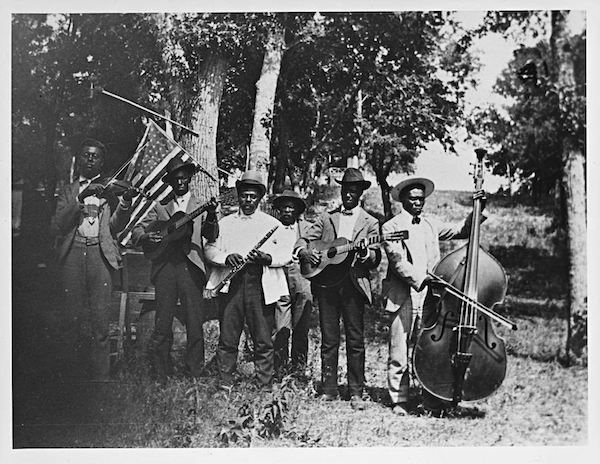This federal holiday is celebrated every 19th of June each year starting year 2021.

Band performing in Texas for Emancipation Day, June 19, 1900
On June 17, 2021, President Joe Biden signed the Juneteenth National Independence Day Act, formally establishing a federal holiday that commemorates the end of slavery in the United States. Known as Juneteenth (short for “June Nineteenth”), this was officially celebrated by the entire country for the first time this year.
So how did Juneteenth become a federal holiday? And, what exactly did people do to celebrate it?
A Brief History of Juneteenth
On the eve of January 1, 1863, enslaved and free African-Americans across the United States gathered together in churches and homes, breathlessly awaiting news about the Emancipation Proclamation. Their prayers were answered when, on the stroke of midnight, all slaves in the Confederate states were declared legally free from their masters.From here on out, this night became known as “Freedom’s Eve.”
However, the Emancipation Proclamation couldn’t be immediately enforced throughout the south. In particular, it was near impossible to do so in places that remained under Confederate control and so, enslaved African-Americans residing in the westernmost Confederate state of Texas were only freed much later.
On June 19, 1865, approximately 2,000 Union troops, many of whom were Black, marched into Galveston Bay, Texas. There, Major General Gordon Granger read out General Order No. 3, which said:
“The people of Texas are informed that, in accordance with a proclamation from the Executive of the United States, ‘all slaves are free.’ This involves an absolute equality of personal rights and rights of property between former masters and slaves, and the connection heretofore existing between them becomes that between employer and hired labor. The freedmen are advised to remain quietly at their present homes, and work for wages. They are informed that they will not be allowed to collect at military posts, and that they will not be supported in idleness either there or elsewhere.”Among the newly freed African-Americans in Texas, this day eventually came to be known as “Juneteenth.” Since then, it has taken on other names, such as “Emancipation Day,” “Freedom Day,” “Jubilee Day,” and “Black Independence Day.”
It’s important to note, though, that it was the adoption of the 13th Amendment and not Juneteenth, that formally abolished slavery in the United States. Ratified on December 6, 1865, it provides that:
“Neither slavery nor involuntary servitude, except as a punishment for crime whereof the party shall have been duly convicted, shall exist within the United States, or any place subject to their jurisdiction.”The first Juneteenth celebration took place in 1866, with freedmen in Texas hosting community gatherings, sporting events, cookouts, prayers, dances, and parades. A slew of spiritual songs was also sung, including the popular “Many Thousands Gone” and “Go Down with Moses.”
Juneteenth continued to be observed in Texas throughout the next few years and the celebrations even began to feature a reading of the Emancipation Proclamation. It became even more significant during the Reconstruction era, which lasted from 1865 to 1877, and saw former slaves attempting to rebuild the Southern economy and society. They established schools, ran for political office, called for the enforcement of radical legislation, and reunified families that had been torn apart by slavery.
Some even sued their former slaveholders for financial compensation.
Considering how African-Americans had been enslaved for nearly two centuries, the Reconstruction era was simply incredible. An entire generation of freedmen was suddenly empowered to drastically transform their lives and their country, working against all odds in the hopes of achieving their goals.
While Juneteenth has been celebrated in Texas since 1866, the state only declared it an official holiday in 1979. Others followed suit and on June 16, 2021, the United States Congress passed a resolution to establish it as a national holiday. The following day, President Joe Biden signed it into law.
How is Juneteenth Celebrated?
In 2021, Americans across the country celebrated Juneteenth in various ways.In Galveston, Texas, a 5,000-square-foot mural was built on the spot where Major General Granger read out the contents of General Order No. 3. Painted by renowned public artist Reginald C. Adams, the masterpiece is emblazoned with the words “Absolute Equality” and chronicles the events that unfolded 156 years ago.
Meanwhile, in Brooklyn, New York, a six-foot statue of George Floyd was unveiled at Flatbush Junction. Created by artist Chris Carnabuchi, it honors the victim of police brutality, whose tragic death in Minneapolis in 2020 sparked a movement for social justice that ultimately spread across the globe.
Similar events took place in other parts of the United States. For instance, a parade was held in Atlanta, Georgia, while the Roots 101 Museum in Louisville, Kentucky launched an art project titled “On the Banks of Freedom.” It explores the role that the state played in enslaving African-Americans and commemorates the enslaved people whose names and lives have been lost to history.